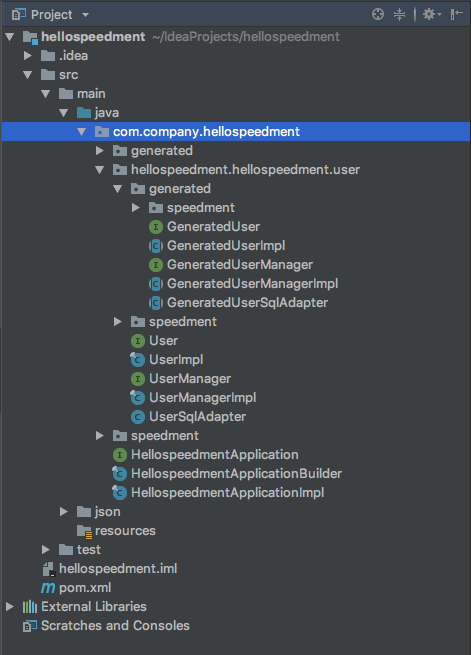Tutorial: Hello Speedment
In this tutorial, we will write a small application that asks for the user's name and age and persists it in a MySQL database. First off, we will initialize the database.
CREATE DATABASE hellospeedment;
USE hellospeedment;We will also add a table for storing the information.
CREATE TABLE IF NOT EXISTS `user` (
`id` bigint(20) NOT NULL AUTO_INCREMENT,
`name` varchar(32) NOT NULL,
`age` int(5) NOT NULL,
PRIMARY KEY (`id`),
UNIQUE KEY `name` (`name`)
) ENGINE=InnoDB DEFAULT CHARSET=utf8 AUTO_INCREMENT=1;We explain how this is done in our Quick Start guides Start a New Speedment Maven Project and Connect to Your Database.
When you are done, you should end up with this structure:

Initializing Speedment is really easy. Create a java Main file and write the following line:
package com.company.speedment.test.hellospeedment;
/**
*
* @author Your name
*/
public class Main {
public static void main(String... params) {
HellospeedmentApplication app = new HellospeedmentApplicationBuilder()
.withBundle(MySqlBundle.class)
.build();
UserManager users = app.getOrThrow(UserManager.class);
}
}In order to tell Speedment what database it will be interacting with, with must add a connector bundle when creating our application instance. This is done by calling withBundle(CONNECTOR_BUNDLE) as shown in the previous example.
Since we are using MySQL, we will be adding the MySqlBundle.
The HellospeedmentApplication-instance is generated automatically by Speedment and will connect to the database and handle all the initialization for you! If you have a password on your MySQL database, you will need to set that manually like this:
HellospeedmentApplication app = new HellospeedmentApplicationBuilder()
.withBundle(MySqlBundle.class)
.withPassword("YourSuperSecretPassword")
.build();Speedment takes your security seriously and will not store your passwords in any configuration files.
Now we will listen to user input. To do this, we use a Scanner on the standard input channel.
final Scanner scn = new Scanner(System.in);Using the scanner we can ask the user for a name and an age. We will not check the validity of the input in this tutorial so we just assume the user inputs everything correctly.
System.out.print("What is your name? ");
final String name = scn.nextLine();
System.out.print("What is your age? ");
final int age = scn.nextInt();Now we want to persist this information to the database. This is done by creating a new entity, setting its values, and calling persist() on it.
users.persist(
users.create()
.setName(name)
.setAge(age)
);We can also react to the query, printing a message if anything failed. This could for an example happen if the name is already persisted.
try {
User user = users.create()
.setName(name)
.setAge(age);
user = users.persist(user);
System.out.print("Hello, " + user.getName() + "!");
} catch (SpeedmentException se) {
System.out.print("Why are you so persistent?");
se.printStackTrace();
}If you want to know exactly what is happening with your persist() command, you can set up the application for logging as follows.
HellospeedmentApplication app = new HellospeedmentApplicationBuilder()
.withBundle(MySqlBundle.class)
.withLogging(PERSIST)
.build();
UserManager users = app.getOrThrow(UserManager.class);
users.persist(
users.create()
.setName(name)
.setAge(age)
);This might give the following output:
What is your name? John Smith
What is your age? 32
sql = insert into hellospeedment.user(id, name, age) values (?, ?, ?)
params = [null, John Smith, 32]
thowable =
If you enter the same name again you might get this output:
What is your name? John Smith
What is your age? 10
sql = insert into hellospeedment.user(id, name, age) values (?, ?, ?)
params = [null, John Smith, 10]
thowable = Duplicate entry 'John Smith' for key 'name'
This was all for this tutorial!
Speedment is available under the Apache 2 license.
Want to learn more about the enterprise version? Visit www.speedment.com!